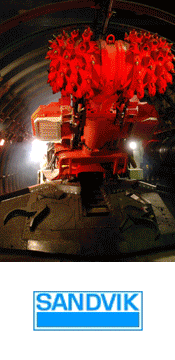Jumbos winning popularity in China
Apr 2011
Sandvik News Release
-
China traditional preference for hand-held air-legs for drilling operations is changing rapidly changing as both labour and energy costs rise significantly. The shift is illustrated well in the Chang Hong Lin tunnel on the new Yu Li high-speed railway line where the main contractor, Department #1 of the Tunnelling Bureau, has taken hand held drilling operations have been taken off site in preference to two Sandvik Axera T11 jumbo drill rigs.
-

Portal of the new high-speed rail tunnel
- In a monumental commitment to national infrastructure, China will have some 13,000km of new railway routes in operation by the end of 2012. Of this 9,200km will be high-speed rail, making it the largest high-speed rail network in the world. More than 40 high-speed railway projects are currently under construction. According to the Ministry of Railways' long-term blueprint, China will have four east-west and four north-south high speed lines.
- One of the high-speed lines currently under construction is the 224km Changqing–Lichuan line, also known as the Yu Li railway.
- It will connect Chongqing North station with Lichuan station on the Yiwan railway and be able to provide direct access to the future Huhanrang line, which will extend from Wuhan, Nanjing and Shanghai. This will allow trains, travelling at 200km/h, to travel from Changqing to Shanghai in just eight hours, a journey taking up to 42 hours previously.
- A key element of the new Yu Li line is the 13.3km long Chang Hong Lin Tunnel on the strategically located 28km section around Enshi. The contract for the tunnel's entrance portal and adit 1 construction was awarded to Department #1 of the Tunnelling Bureau.
-

Sandvik jumbos work side by side in the 110m2 double track heading
- In the low mountain foothills that rise to between 300m and 800m and with a maximum cover on the tunnel alignment of 420m, the contractor is experiencing shale and Jurasic Continental Clastic rock conditions.
- To excavate the double-track rail, the contractor has selected to use two Sandvik Axera T11 jumbos. These drill all charge holes for full-face drill+blas excavation of the 10m high x 13m wide single-tube, double-track rail tunnel. From the portal both 3-boom Sandvik rigs are being used in a side-by-side operation to drill a total of 140 x 48mm diameter x 3.7m deep charge holes in each 110m² face. Both jumbos are achieving penetration rates generally of 2m/min in the relatively soft ground conditions.
-
Traditional advance of Adit 1
By contrast, the contractor chose to use low cost, labour intensive traditional drill+blast techniques to excavate the 2,000m long adit located some 2km along the tunnel. Up to 22 locally manufactured hand-held drills powered by six stationary air compressors advanced the 80m² cross section adit which was completed in March 2010. - Apart from the ever increasing labour costs in China, making hand held drilling less competitive compared with jumbo rigs, rising energy costs similarly became a factor as the portal advanced, requiring additional compressors to meet the increased air supply.
- In penetration comparisons, the contractor was able to note that the combined hand held drills were only able to achieve an advance rate of just 0.7m/min in the soft rock and less in harder conditions. This compared with 2m/min using the Sandvik jumbos. Evaluations proved that total excavation times using the two 3-boom jumbos were considerably faster than the many hand held units.
- As a direct result of these comparisons, the contractor removed all its hand held drills from the contract early last year, relying solely on its two Sandvik Axera's, which by the end of 2010 had advanced more than 4km into the tunnel. A further factor in the contractor's decision to rely on the jumbos was the high availability of the Sandvik rigs and the back up support of the local operation.
-
Drilling cycles
The two 3-boom jumbos are taking an average 2 hours to complete the 140 charge holes in each 110m2 face with up to an hour to set charges and initiate the blast. A further 3 hours are allocated for mucking out plus 30 minutes for scaling, and with up to 4 hours for installing the pattern of support rock bolting, the sequence is completed following screening and surveying in a total of 14.5 hours. -

Project manager expressing satisfaction with mechanised drilling
- Working around the clock, the contractor is completing an average of 1.85 blasts per day.
- Initially, hand-held drills were also used to drill bolt holes into the soft rock conditions in both the Adit 1 and main tunnel headings. Now, only the faster and more efficient 3-boom Sandvik rigs are used also to bolt drilling duties.
- Along with other process in the drill+blast tunnelling cycle, China is moving quickly towards higher productivity, lower labour intensive and much safer mechanical jumbo drilling operations and laying aside the more traditional hand-held options.
- Sandvik China has enjoyed considerable success in recent years convincing local contractors to recognise the cost savings and make the transition.
- India builds its first oil storage caverns - TunnelTalk, March 2011
Jumbos drive Malaysia's rail connector - TunnelTalk, Jan 2011
Tough rigs for tough conditions in Turkey - TunnelTalk, October 2010
|
|
|
|
|
Add your comment
- Thank you for taking the time to share your thoughts and comments. You share in the wider tunnelling community, so please keep your comments smart and civil. Don't attack other readers personally, and keep your language professional.

